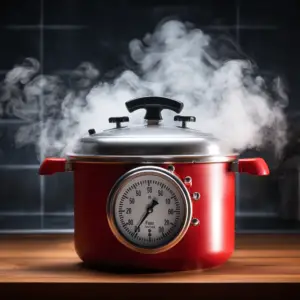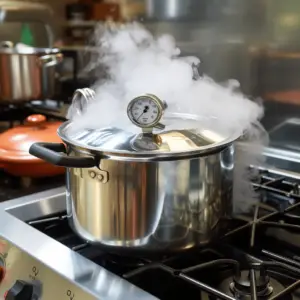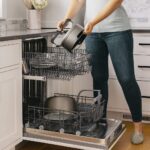Pressure Cooker Safety allow us to cook faster and save up to 70% of energy especially on foods that usually take longer to cook or boil such as beans and other legumes, certain meats such as intestines and ligaments as well as boiling bones to leech out calcium and other micronutrients.
Most cultures around the world have some form of pressure cooking method with the store-bought version largely made of stainless steel being the most widely used. Heat is a dangerous enough force without pressurizing it so it is important to understand the safety mechanisms in place when using the pressure cooker and adhere to them.
Pressure-cooking is generally very safe, and more so if the cooker is in good condition and the instructions for use are followed to the letter. Most pressure cooker accidents occur due to a false sense of safety that comes with years of use and a worn-out pressure cooker.
If your pressure cooker is emitting steam from the safety valve, here’s why and what you should do.
Table of Contents
Why Steam Comes out of the Safety Valve of your Pressure Cooker

A pressure cooker that is in tip-top shape should never emit steam from the safety valve since the safety valve is the contingency measure put in place to prevent the cooker from blowing off its lid when pressure exceeds the maximum psi.
How pressure cookers work
- Water boils at 100 degrees Celcius (at sea level) after which it begins to evaporate. The steam lost is wasted energy.
- Boiling food in water means that it can only cook at 100 degrees Celcius.
- A pressure cooker is made of thicker material and a locking mechanism that prevents steam from escaping.
- The trapped steam can then be used to cook the food since steam is even hotter than boiling water.
- The trapped steam begins to accumulate pressure which drives up its temperature even further.
- With no place to go the pressurized hot steam bears down on the food breaking it down that much faster which is basically the process of cooking.
- The heated steam inside a pressure cooker can reach temperatures of between 120 – 140 degrees Celcius which is a massive increase in temperature compared to the normal boiling temperature of the water which is 100 degrees Celcius at sea level.
- As long as the heat source keeps going the pressure and heat will continue to build up. This means that the whole unit is a pressure bomb waiting to blow.
How pressure cookers work
- To stave off this explosion, when the pressure can no longer be contained, it pushes its way through the pressure vent lifting the weighted pressure regulator and releasing the excess steam.
- The pressure vent or opening is the one in the middle of the lid.
- This brings the pressure back down to the preset levels which should be between 10 – 15 psi depending on the model.
- The food continues to cook and this cycle keeps going. Every ten or so minutes you should see and hear the pressure regulator release excess steam with a high hissing sound.
- The pressure regulator could fail to release this pressure for any number of reasons and when it cannot do so, the pressure inside continues to exert force in an effort to escape.
- The safety valve gets blown allowing the pressurized steam to escape safely before the lid is blown off which would cause property damage and serious burns to anyone whose nearby.
- The safety valve is the vent located adjacent to the pressure regulator and contains a small metal disc in the middle. This disc is what is dislodged by the excess pressure when the pressure regulator fails.
- Usually when the safety valve blows contents of the cooker are blown out too since there is no weight to stop this.
Even a small leak of steam from the safety valve means the pressure cooker is no longer functioning as it should and that the pressure regulator is not working anymore. The pressure regulator can fail for the following reasons.
The pressure vent is blocked
Some foods especially meats and bones can produce fats that over time block the pressure vent. You may fail to notice this when cleaning the pressure cooker and eventually the fats form a solid so hard that even the heat inside the pressure cooker cannot push it out in time to allow the regulator to do its job.
Excess water in the food

There is the misconception that more water equals more steam and faster cooking. The opposite is true. Despite the amount of water you put in, the steam generated is what cooks the food which means more water can slow down the cooking.
The pressurized steam cooks the food that is above water while what is submerged cooks in normal boiling water so less water equals faster cooking. The best level of water plus the food is two-thirds the volume of the cooker which leaves room to create the pressurized steam that you are going for.
Excess water means the residue from food will continually reach the pressure regulator creating a barrier that prevents it from functioning correctly eventually triggering the safety valve to release the steam.
- The cooker is old and worn out.
- The cooker brand was of poor quality.
- The body of the cooker is damaged.
The safety valve should simply be replaced since there is no way to repair it. Even if there was, there would be no point in doing so since a new valve should cost between $ 5 and $ 15.
Pressure cookers come with a spare safety valve so if you can find it, you are in luck, and replacing it should be as easy as undoing the old one and placing the new one, tightening it with a pair of pliers.
For the sake of safety, let the attendant at the nearby hardware store do this for you if you have never done it before. If your pressure cooker has a mileage of over six years, replace the cooker and not the valve.


